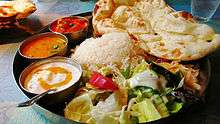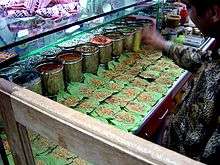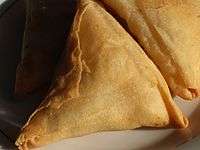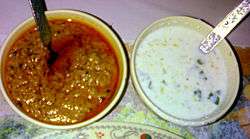Cuisine of Karachi
 |
| This article is part of the series |
| Pakistani cuisine پاکستانی پکوان |
|---|
|
See also
|
|
Karachi cuisine (Urdu: کراچی پکوان) refers to the food found mainly in the city of Karachi, Sindh, Pakistan. The cuisine of Karachi is strongly influenced by the city's Urdu speaking Muslims, also known as Muhajir population, who came from northern India and settled in Karachi after the independence of Pakistan in 1947. Most Urdu speaking Muslims have traditionally been based in Karachi, hence the city is known for Muhajir tastes in its cuisine. Urdu speaking Muslims maintained their old established culinary traditions, including variety of dishes and beverages.
The Mughal and Hyderabadi cuisine played an influential role in the making of their cuisine, having taste vary from mild to spicy and is often associated with aroma. In comparison to other Pakistani dishes, Muhajir cuisine tends to use stronger spices and flavors. Most of a dastarkhawan dining table include chapatti, rice, dal, vegetable and meat curry. Special dishes include biryani, Pulao, qorma, Paya. kofta, seekh kabab, Nihari, Haleem, Nargisi Koftay, Kata-Kat, Rogani Naan, Naan, sheer-qurma (sweet), chai (sweet, milky tea), and paan.
The food of Urdu speaking Muslims is renowned for its cultural fusion, due to Muhajirs migrating from the different ethnic and regions of India. As a result, Bengali cuisine, Gujarati cuisine, Bihari cuisine, Uttar Pradeshi cuisine and Muslim Hyderabadi cuisine collaboratively had an influence on the style of Muhajir food.
-

Boti Kabab.
-

Thali with naan, sultani dal, raita, and shahi paneer
-

Kebabs are an important part of the ancient Muslim cuisine.
-

Chota Samosa - a crispy, onion-filled variant
-

Paan Shop
-

The samosa
-

Korma, a traditional cuisine originated from ancient Lukhnow royals.
Cuisine of muhajir people of Hyderabad Deccan (now Hyderabad, India)
-
Hyderabadi Haleem a starter stew.
-

Hyderabad mutton biryani served with mirchi ka salan.
-

Mirchi ka salan and Dahi ke chutney ( Chilli curry with spices and Yougurt curry) Biryani Accompaniments.
-
Double ka meetha one of dessert.
-
Faluda, an sweet beverage after dinner.
-
Lukhmi, a snack, prepared stuffing with mutton-mince is an Hyderabadi cuisine
Historical influences
The arrival of Islam within South Asia influenced the local cuisine to a great degree. The influence of the Central Asian, South Asian and Middle Eastern cuisine in Pakistani food is ubiquitous. Since Muslims are forbidden to eat pork or consume alcohol and the Halal dietary guidelines are strictly observed. Pakistanis focus on other areas of food such as beef, lamb, chicken, fish, and vegetables as well as traditional fruit and dairy.
Dishes
- Bakarkhani or Baqerkhani
- Bun kebab
- Chicken tikka
- Dalcha (also called Dal Gosht)
- Dosa
- Double ka meetha
- Falooda (Urdu: فالودہ)
- Golgappa (also called Panipuri)
- Haleem
- Halwa poori
- Hyderabadi biryani ( Urdu: حیدرآبادی بریانی)
- Jalebi
- Kachori
- Kadhi or karhi (Urdu: کڑھی)
- Kata-kat
- Kheer
- Kofta (Urdu:كوفته )
- Kulcha (Urdu: کلچه)
- Lukhmi (Urdu: لقمی)
- Namak para
- Nargisi kofta
- Nihari, a popular national dish in Pakistan, was originally brought by Muhajirs (immigrants) from Delhi, India.
- Paan (Urdu: پان), a traditional Muhajir betel leaf stimulant
- Pakora
- Pakora ( Urdu: پکوڑا)
- Pulao (Urdu: پلاؤ)
- Qorma (Urdu: قورمه)
- Rabri
- Raita
- Ras malai
- Sajji
- Samosa
- Shami kebab
- Shawarma
- Sheer korma or Sheer Khurma
- Sheermal or Shirmal (Urdu: شیرمال)
- Siri paya
- Taftan (Urdu: تافتان)
- Ajwain Paratha
- Alloo & Chana Chaat / Cholay
- Aloo (Potato) Paratha (Urdu: آلو پراٹھا)
- Anda (Egg) Paratha
- Bihari Kebab
- Boti Kebab
- Channa Dal paratha
- Chargah
- Chicken karahi
- Dahi Baray
- Dhaniya Paratha
- Fry Kebab
- Gajer Ka Halwa
- Galawati Kebab
- Gil e firdaus
- Gobhi (Cauliflower) Paratha
- Gola Kebab
- Habshi Halwa
- Kache Qeema Kebab
- Kaleji (liver) Kabab
- Kebab roll
- Lamb karahi
- Lamb Tikka
- Lauki ka Paratha
- Luki Ka Halwa
- Mashed dal Paratha
- Mattar (peas) Paratha
- Methi (fenugreek leaves) wala Paratha
- Mooli (Reddish ) Paratha
- Murgh -e- Musallam
- Pasinday (Urdu: پسندے)
- Phirini
- Pyaz (onion) ka Paratha
- Qeema Naan
- Qeema Paratha
- Reshmi Kebab
- Rizala
- Rumali Roti (Urdu: رومالی روٹی)
- shab-daig
- Shahi Tukray
- Sheekh Kebab
- Sultani Dal
- Tandoori Paratha
- Tehri
- Warqui (layered) Paratha
- Zamin Doz Macchli (fish stuffed with spices and sealed in earthenware case which is then cooked for 8 hours)
See also
- Karachi Bakery, a bakery chain in India
- North Indian cuisine
- Hyderabadi cuisine
- Mughlai cuisine
